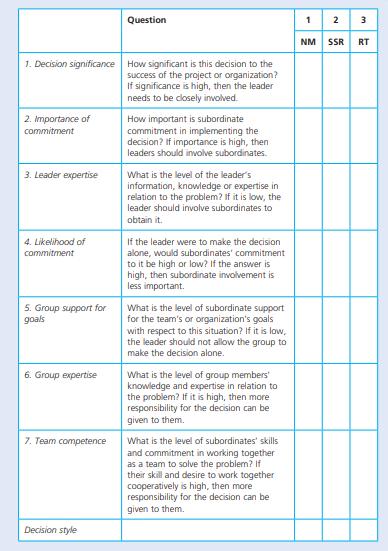You are a manufacturing manager in a large electronics plant. The companys management has recently installed new
Question:
You are a manufacturing manager in a large electronics plant. The company’s management has recently installed new machines and put in a new, simplified work system. To everyone’s surprise, the expected rise in productivity has not occurred. In fact, production has begun to drop off, quality has fallen, and staff turnover has increased. You do not believe that there is anything wrong with the machines. Other companies using them confirm this opinion, and representatives from the firm that built the machines report that they are operating at peak efficiency. You suspect that some parts of the new work system may be responsible for the change, but this view is not widely shared among your five immediate subordinates – four first-line supervisors, each in charge of a section, and your supply manager. They are all as concerned as you are, since it affects company profitability and thus their jobs. Each one has their own explanation based on their specialist knowledge. The drop in production has been variously attributed to poor training of the operators, lack of an adequate system of financial incentives, and poor morale. Clearly, this is an issue about which there is considerable depth of feeling among individuals and a source of potential disagreement among your subordinates. This morning you received a phone call from your divisional manager. He had just received your production figures for the last six months and was calling to express his concern. He indicated that the problem was yours to solve in any way you thought best. However, he wanted to know within a week what steps you planned to take. You share your divisional manager’s concern with the situation.
You are the head of a research and development (R&D) unit for a major beer company, overseeing the work of a team of scientists. They work together well, successfully contributing to different projects. One of the scientists in your unit seems to have tentatively identified a new chemical compound that has few calories but tastes more like sugar than current sugar substitutes. The company has no foreseeable need for this product, but it could be patented and licensed to manufacturers in the food industry, and be a money-earner. Since the sugar substitute discovery would require considerable time and resources to make it commercially viable, these would need to be taken away from other projects in the lab. The sugar substitute project is beyond your technical expertise, but some of the lab researchers are familiar with that field of chemistry. The amount of research needed to perfect the substitute is difficult to determine, and you do not know how much demand there would be for it. There are no rules about funding projects that would be licensed but not used by the organization. The company’s R&D budget is limited, and the scientists in your work group have recently complained that they require more resources and financial support to complete their current projects. Some of these have a potential for increasing future beer sales. You believe that most researchers in the R&D unit are committed to ensuring that the company’s goals are achieved.
You are the director of a repertory theatre, responsible for both its artistic and financial direction. While recognizing the importance of both sets of responsibilities, your own interests and talent have led you to focus on securing the highest level of quality for the theatre’s productions. Four departmental heads, responsible for administration, production, marketing, and development, report to you. Over the years, they have worked together effectively to mount numerous successful productions. Last week you received a report from an accounting firm commissioned to assess the financial health of your theatre. You were surprised to discover that the theatre’s expenses were greatly exceeding its income, and shocked by the report’s conclusion that unless expenses were reduced, the theatre might have to close in a year’s time. You have circulated the report to your staff, and have been surprised at the variety of their reactions to it. Some dispute the report’s conclusions, challenging its assumptions and methods of calculation. Others accept the findings but, shaken by its implications, are divided about what steps should be taken and when. However, what everybody is agreed on is that the theatre should not be closed.

1. Form into groups.
2. Read the scenarios as directed by your instructor.
3. Apply the Vroom-Yetton-Jago model described in the chapter, using the decision making sheet below.
4. Agree the most appropriate decision-making style in each scenario.
5. Based on your experience of this approach, what problems would a manager encounter in trying to apply this model?
Step by Step Answer:

Organizational Behavior
ISBN: 978-0273774815
8th Edition
Authors: Andrzej A. Huczynski, David A. Buchanan





